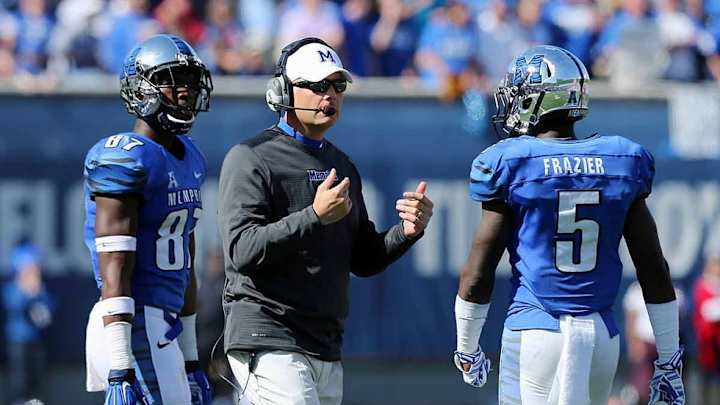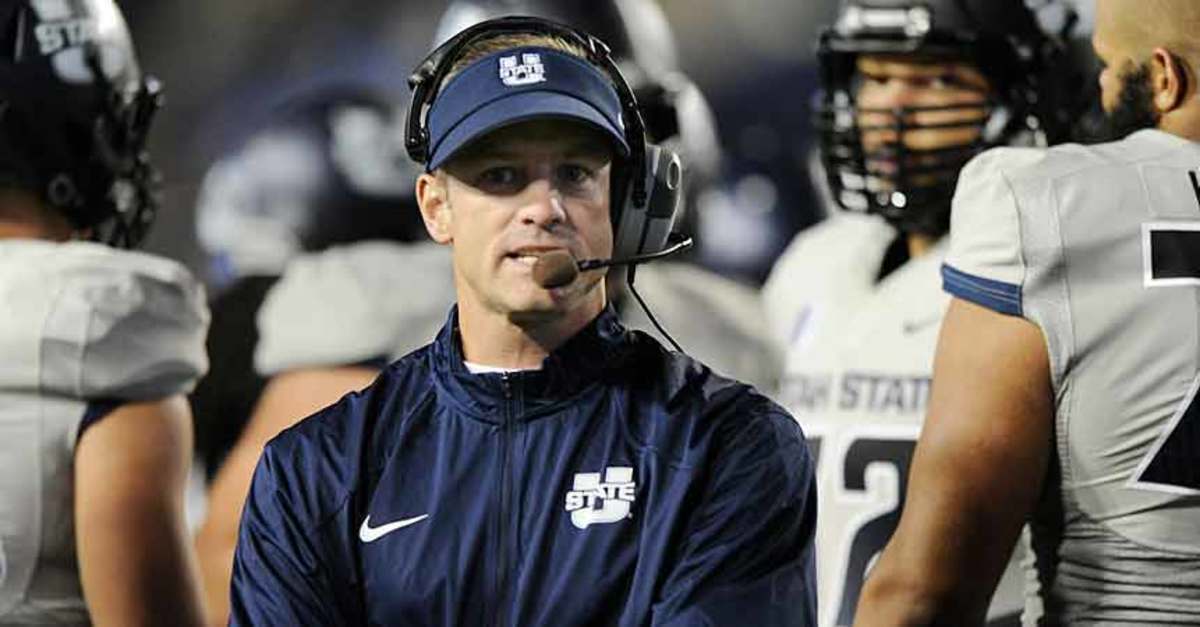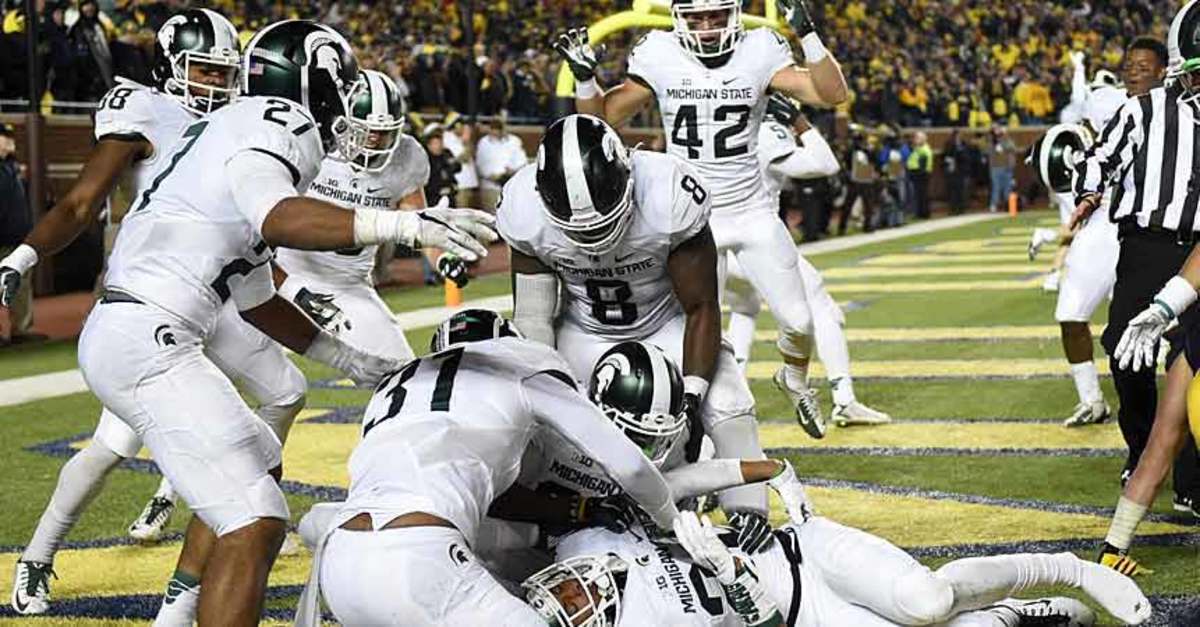In a big year for the Group of Five, many coaches will be in high demand; however, moving up isn't a no-brainer

The latest Associated Press Top 25 reflects one of the subtle themes running through this college football season—it's been a big year for small schools. There are four ranked teams from outside the Power Five conferences, with as many teams (3) from the American Athletic Conference as the Pac-12.
No. 18 Memphis (6–0) trounced Ole Miss this weekend, leading to the highest ranking in school history. No. 21 Houston (6–0) overwhelmed Tulane last Friday night and No. 22 Temple (6–0) edged out UCF and found its way into the Top 25 for the first time since 1979.
Elsewhere in the Group of Five, No. 19 Toledo has the school's highest ranking since 1997 after upsetting Arkansas and Iowa State. Utah State isn't ranked, but the Aggies delivered the most stunning result of the weekend: a 52–26 rout of No. 21 Boise State.
The small school uprising coincides with an expected historic rate of turnover among coaches in Power 5 conferences. Already there are already four Power 5 jobs open: Illinois, USC, Maryland and South Carolina. A flurry of others could become available, including Miami, Virginia Tech, Virginia, Syracuse, Iowa State, Indiana, Purdue, Colorado and Rutgers. Of those jobs, only Miami and Virginia Tech are considered among the upper-tier in their leagues.
This sets the stage for a collision course of the bevy of hot young coaches and pedestrian jobs at Power 5 schools. And it presents an age-old college football conundrum. Coaches like Memphis' Justin Fuente, Temple's Matt Rhule, Houston's Tom Herman, Utah State's Matt Wells and Toledo's Matt Campbell may face the choice of leaving a school where they've established a winning tradition for one that's languished for decades at the bottom of its conference.
"I'd tell those guys to be really, really careful," says Dan Hawkins, who led Boise State to prominence before leaving for Colorado. "Make sure you pump the brakes and take a look at the big picture. Is it a good fit geographically, culturally and socially? What's the administrative commitment? Have they been successful?"
Hawkins added with a laugh: "They're all good coaches, but you can't go in there and draw up magic pixie dust."
Hawkins can identify because he was once the hot mid-major coach. He went 53-11 in five seasons at Boise State before leaving for Colorado after the 2005 campaign. He turned down interest from a half-dozen Power 5 schools, including Notre Dame. But Colorado didn't work out, as Hawkins went 19–39 there and got fired in 2010. Since then, he's called games for ESPN and had a short stint coaching in the CFL. Traveling around for ESPN, he finds himself counseling coaches and coordinators in a rush to move up.
One paradigm that's changed with this era of mid-major coaches is salaries. Hawkins made around $500,000 when he left Boise in 2005. Herman and Fuente both make close to $1.4 million, meaning there's likely less incentive to take a lower-tier Power 5 job. (On the USA Today coaching salary list for 2015, both are listed ahead of Indiana's Kevin Wilson at $1.3 million).
Hawkins said in hindsight he would have asked more questions about commitment to football and demanded any promises be put in writing. Decisions for coaches to leave are often made in a rush with little time to do proper research. Hawkins said he's never talked to Gary Andersen about leaving Wisconsin after two seasons for Oregon State in 2014, but that's seemingly an example of a coach not finding the right fit.
"For whatever reason, that was not a good fit," Hawkins said. "That's a lot of the stuff you have to have ironed out, ask the tough questions and get things down in writing and sort it out. It takes a little bit of savvy and understanding."
In 1994, Rip Scherer had James Madison in the Top 10 of Division I-AA. James Madison lost to Marshall in the quarterfinals of the FCS Playoff and Scherer ranked among the hottest coaches in the country. He went against the advice of his mentor, Joe Paterno, and took the head coaching job at Memphis. In six seasons there, he went 22–44 and never landed another head coaching job. Scherer is now an associate athletic director at UCLA and admits he got too caught up in moving up to Division I instead of finding the right landing spot.
"Just don't look at the size of the stadium and the budget and those kinds of obvious and superficial things," he said. "It's more of looking at the long-term commitment. What's the plan to move that program to the next level? Everything from a commitment standpoint—facilities, budget and also scheduling."
Scherer cited the press conference former Memphis coach TommyWest gave after his dismissal in 2009. The speech was played on ESPN during the Memphis upset this weekend, and in it West pleaded with the university to give more support to his successor, what he called "an equal stick to fight with."
"I'm the seventh straight coach that stands here saying the same thing," West said. "This is the seventh straight time this has happened. History will continue to repeat itself if they don't do something about it."
The streak went to eight with the firing of Larry Porter, West's successor, in 2011 before Fuente reversed the trend of decades of losing. Now the trick will be finding the right landing spot for longterm success in a place better equipped to win. Scherer serves as a cautionary tale that you can't recapture the magic of being a hot young coach. "Once you fail or get fired," Scherer said, "no matter how much success you had at the previous place, you don't get another shot."

Gene Sweeney Jr./Getty Images
12 Mid-Major Coaches on the Rise
Here are the top 12 mid-major head coaches who could be facing tough choices the next few months:
1. Justin Fuente, Memphis: His 19–3 record at Memphis the last two years is remarkable considering the program's history of ineptitude. There's a lot to like about Fuente, including his pedigree as an offensive assistant at TCU before coming to Memphis. Now that he has a signature victory, his phone will be ringing off the hook.
2. Matt Wells, Utah State: A 52–26 upset of No. 21 Boise wasn't as surprising as the tenor of it. The Aggies forced eight turnovers and the game could mark a paradigm change in the Mountain West, especially considering Boise beat Utah State 50–19 last season. Wells is 23–11 in his third season, and he'll be a top candidate for any Pac-12 jobs—non-USC division—that open.
3. Tom Herman, Houston: He's 6–0 through his six games as a head coach. Lack of head-coaching experience makes it tricky to put him ahead of more seasoned candidates, but he could have the largest upside. Herman has Houston ranked No. 21 despite being down three starters on the offensive line. His resume includes working under Urban Meyer, who has a solid track record of producing head coaches—Charlie Strong (Texas), Dan Mullen (Mississippi State), Doc Holliday (Marshall), Steve Addazio (Boston College), Kyle Whittingham (Utah) and Gary Andersen (Oregon State).
4. Bryan Harsin, Boise State: Harsin may have been No. 1 on this list before last weekend, as Boise won the Fiesta Bowl last season. But coaching is a week-to-week business and Harsin had a bad week against Utah State. Harsin's resume includes a 17–4 record at Boise, a 7-5 season at Arkansas State and coordinator experience at Texas. He likely doesn't have the juice for USC, but will be in the mix for a lot of jobs this fall.
5. Matt Campbell, Toledo: That Campbell is this far down the list is proof how stocked this class of mid-major coaches is. The No. 19 Rockets have upset Arkansas and Iowa State this season, and Campbell is 32–13 in his fourth full season as head coach. Campbell will be high on the list of a lot of Big Ten schools, as there's a flurry of jobs expected to open in the bottom-half of that league. A MAC title would be Toledo's first since 2004 and the final polish on Campbell's resume.
6. Matt Rhule, Temple: From getting kicked out of the Big East a decade ago to the Top 25, it's been quite a swing for Temple. Rhule picked up a signature victory over Penn State earlier this season, blowing out the Nittany Lions 27–10. Rhule has built the Owls with a slow burn through careful recruiting and player development, as Temple went 2–10 and 6–6 his first two seasons. He has a few more chances at hallmark wins this fall, as Temple hosts Notre Dame on Halloween and Memphis on Nov. 21.
7. Doc Holliday, Marshall: He's 29–6 the past three seasons, 3–0 in bowl games in his career and his teams play a wide-open style that's attractive to recruits and ADs. He's also a prolific recruiter of South Florida, which should put him in the mix at USF, UCF and Miami. Marshall is 6–1 and headed for another double-digit win season.
8. Rod Carey, Northern Illinois: Carey may have improved his resume most this season by NIU's strong showing at No. 1 Ohio State in a 20–13 loss in September. His 27–9 record and last year's MAC championship make him an obvious candidate for any Big Ten jobs that open. Carey is an Indiana graduate and could end up on that school's short list if the job opens.
9. Jeff Brohm, Western Kentucky: He's 14–6 through two seasons, including a victory over Vanderbilt earlier this year. Athletic directors want offense, and WKU is in the Top 10 in scoring offense, passing offense and total offense. Brohn is 44, played seven seasons in the NFL and has a showcase game at LSU on Saturday night.
10. Willie Fritz, Georgia Southern: Fritz has a strong track of winning everywhere he's gone, including a Sun Belt title his first season. Georgia Southern (5–1) went 8–0 in the league last year and is 14–4 in his two seasons there. Georgia Southern blew out Western Michigan earlier this season, and its only loss is to West Virginia. Fritz is 55, which means he's got one more stop in him.
11. Dino Babers, Bowling Green: The Falcons's 48–27 blowout victory at Maryland opened a lot of eyes, as did their win over Indiana last season. Babers brings a strong offensive pedigree; he learned under Art Briles at Baylor and helped develop Jimmy Garoppolo at Eastern Illinois. Babers inherited star quarterback Matt Johnson at Bowling Green and has turned him into No. 1 quarterback in the country in passing yards (2,891) and No. 3 in touchdown passes (24).
12. P.J. Fleck, Western Michigan: At 34, he's the youngest coach in the FBS and perhaps the most intriguing, with his endless stream of energy and catch phrases. His 12-19 record is offset, in part, by the best recruiting classes in the MAC the past two seasons. Western went 8–5 last year and has the talent to compete for the league title this season. It will be fun to see the Broncos play Toledo and Bowling Green in November.

Melanie Maxwell/The Ann Arbor News/MLive.com via AP
Behind Michigan State's special teams miracle
All week Michigan State special teams coordinator Mark Snyder had his unit practice punt block for situations like Saturday. Only this one was much more dire with Michigan up by two with 10 seconds remaining. All the Wolverines needed to do was punt the ball away and they would have likely beaten the seventh-ranked Spartans.
As Snyder sent his punt block team onto to the field, one of his players made a rallying cry. "We've got to make something happen right now!" the player screamed.
That would take a miracle, which is why when Michigan snapped the ball from the Michigan State 47-yard line, Snyder did what the same thing as every other Spartans fan.
"I wished," Snyder tells The Inside Read.
What happened next was one of college football's most improbable endings—Michigan State safety Jalen Watts-Jackson returned a botched Michigan snap 38 yards for a touchdown on the final play, giving the Spartans a miraculous 27–23 win.
"I can't ever recall anything like it," Snyder says. "Not that way."
Even crazier than Watts-Jackson's return was that the 5' 11", 192-pound redshirt freshman fractured his hip on the play as he was tackled falling in the end zone. He had surgery Sunday in Ann Arbor.
"There were so many emotions during the run," Snyder says. "You're thinking, does he get down? Does he get out-of-bounds to kick the field goal?"
Snyder initially thought Watts-Jackson should try to give Michigan State a chance to kick a game-winning field goal. That was until Snyder saw Spartans redshirt junior Jermaine Edmondson emerge near the Michigan 15-yard line to block the lone Wolverines defender between Watts-Jackson and the end zone.
"I was going crazy," Snyder says. "I was going absolutely berserk."
So were Michigan State fans again, as the Spartans (7–0, 3–0) now have four victories this season by a touchdown or less.
"We're winning close games, that's what's nice," Snyder says. "There's something to that. It's a belief. That's what's going on here. These guys don't think they can lose even if it's the final play."
Miracle wins have become commonplace lately for the Spartans under ninth-year coach Mark Dantonio. His team scored 21 straight points after being down by 20 late in the third quarter of last season's Cotton Bowl to stun Baylor 42–41 in the game's final seconds.
"The kids believe," Snyder says. "Coach Dantonio has done a great job of instilling that you play to the end. You play to the very end."
For a daily dose of college football insight, check out The Inside Read every weekday on Campus Rush.
